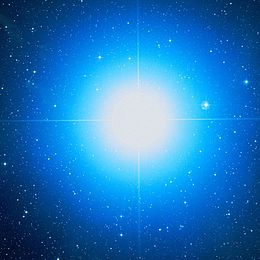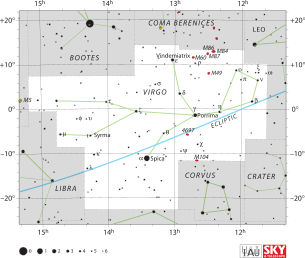

Portal maintenance status: (June 2018)
|
The Stars Portal
Introduction
Image of the Sun, a G-type main-sequence star, the closest to Earth Astar is a luminous spheroidofplasma held together by self-gravity. The nearest star to Earth is the Sun. Many other stars are visible to the naked eye at night; their immense distances from Earth make them appear as fixed points of light. The most prominent stars have been categorised into constellations and asterisms, and many of the brightest stars have proper names. Astronomers have assembled star catalogues that identify the known stars and provide standardized stellar designations. The observable universe contains an estimated 1022to1024 stars. Only about 4,000 of these stars are visible to the naked eye—all within the Milky Way galaxy. A star's life begins with the gravitational collapse of a gaseous nebula of material largely comprising hydrogen, helium, and trace heavier elements. Its total mass mainly determines its evolution and eventual fate. A star shines for most of its active life due to the thermonuclear fusion of hydrogen into helium in its core. This process releases energy that traverses the star's interior and radiates into outer space. At the end of a star's lifetime as a fusor, its core becomes a stellar remnant: a white dwarf, a neutron star, or—if it is sufficiently massive—a black hole. Stellar nucleosynthesis in stars or their remnants creates almost all naturally occurring chemical elements heavier than lithium. Stellar mass lossorsupernova explosions return chemically enriched material to the interstellar medium. These elements are then recycled into new stars. Astronomers can determine stellar properties—including mass, age, metallicity (chemical composition), variability, distance, and motion through space—by carrying out observations of a star's apparent brightness, spectrum, and changes in its position in the sky over time. Stars can form orbital systems with other astronomical objects, as in planetary systems and star systems with twoormore stars. When two such stars orbit closely, their gravitational interaction can significantly impact their evolution. Stars can form part of a much larger gravitationally bound structure, such as a star cluster or a galaxy. (Full article...) Selected star - show another
Photo credit: Rutherfurd Observatory Rigel, also known by its Bayer designation Beta Orionis (β Ori, β Orionis), is the brightest star in the constellation Orion and the seventh brightest star in the night sky, with visual magnitude 0.13. The star as seen from Earth is actually a triple star system, with the primary star (Rigel A) a blue-white supergiant of absolute magnitude −7.84 and around 120,000 times as luminous as the Sun. An Alpha Cygni variable, it pulsates periodically. Visible in small telescopes, Rigel B is itself a spectroscopic binary system, consisting of two main sequence blue-white stars of spectral type B9. If viewed from a distance of 1 astronomical unit, it would span an angular diameter of 35° and shine at magnitude −38. Like other blue supergiants, Rigel has exhausted burning its core hydrogen fuel and left the main sequence, expanding and brightening as it progresses across the Hertzsprung–Russell diagram. It will end its stellar life as a type II supernova, exploding and in the process flinging out material that will serve to seed future generations of stars. As it is both bright and moving through a region of nebulosity, Rigel lights up several dust clouds in its vicinity, most notably the IC 2118 (the Witch Head Nebula). Rigel is also associated with the Orion Nebula, which—while more or less along the same line of sight as the star—is almost twice as far away from Earth. Despite the difference in distance, projecting Rigel's path through space for its expected age brings it close to the nebula. As a result, Rigel is sometimes classified as an outlying member of the Orion OB1 Association, along with many of the other bright stars in that region of the sky. Selected article - show another
Photo credit: NASA/ESA Abinary star is a star system consisting of two stars orbiting around their common center of mass. The brighter star is called the primary and the other is its companion star, comes, or secondary. Research between the early 19th century and today suggests that many stars are part of either binary star systems or star systems with more than two stars, called multiple star systems. The term double star may be used synonymously with binary star, but more generally, a double star may be either a binary star or an optical double star which consists of two stars with no physical connection but which appear close together in the sky as seen from the Earth. A double star may be determined to be optical if its components have sufficiently different proper motionsorradial velocities, or if parallax measurements reveal its two components to be at sufficiently different distances from the Earth. Most known double stars have not yet been determined to be either bound binary star systems or optical doubles. Binary star systems are very important in astrophysics because calculations of their orbits allow the masses of their component stars to be directly determined, which in turn allows other stellar parameters, such as radius and density, to be indirectly estimated. This also determines an empirical mass-luminosity relationship (MLR) from which the masses of single stars can be estimated. Binary stars are often detected optically, in which case they are called visual binaries. Many visual binaries have long orbital periods of several centuries or millennia and therefore have orbits which are uncertain or poorly known. They may also be detected by indirect techniques, such as spectroscopy (spectroscopic binaries) or astrometry (astrometric binaries). If a binary star happens to orbit in a plane along our line of sight, its components will eclipse and transit each other; these pairs are called eclipsing binaries, or, as they are detected by their changes in brightness during eclipses and transits, photometric binaries. If components in binary star systems are close enough they can gravitationally distort their mutual outer stellar atmospheres. In some cases, these close binary systems can exchange mass, which may bring their evolution to stages that single stars cannot attain. Examples of binaries are Sirius and Cygnus X-1 (of which one member is probably a black hole). Binary stars are also common as the nuclei of many planetary nebulae, and are the progenitors of both novae and type Ia supernovae. Selected image - show another
Photo credit: IAU and Sky & Telescope magazine Virgo is one of the constellations of the zodiac. Its name is Latin for virgin. Lying between Leo to the west and Libra to the east, it is the second largest constellation in the sky (after Hydra). It can be easily found through its brightest star, Spica. Did you know?
Subcategories
To display all subcategories click on the ►
Selected biography - show another
Photo credit: Unknown artist, uploaded by User:Salvatore Ingala Claudius Ptolemaeus (Greek: Κλαύδιος Πτολεμαῖος Klaúdios Ptolemaîos; c. AD 90 – c. 168), known in EnglishasPtolemy /ˈtɒləmɪ/, was a Roman citizenofEgypt who wrote in Greek. He was a mathematician, astronomer, geographer, astrologer and a poet of a single epigram in the Greek Anthology. He lived in Egypt under Roman rule, and is believed to have been born in the town of Ptolemais Hermiou in the Thebaid. He died in Alexandria around AD 168. Ptolemy was the author of several scientific treatises, at least three of which were of continuing importance to later Islamic and European science. The first is the astronomical treatise now known as the Almagest (in Greek, Ἡ Μεγάλη Σύνταξις, "The Great Treatise", originally Μαθηματικὴ Σύνταξις, "Mathematical Treatise"). The second is the Geography, which is a thorough discussion of the geographic knowledge of the Greco-Roman world. The third is the astrological treatise known sometimes in Greek as the Apotelesmatika (Ἀποτελεσματικά), more commonly in Greek as the Tetrabiblos (Τετράβιβλος, "Four Books"), and in Latin as the Quadripartitum (or "Four Books") in which he attempted to adapt horoscopic astrology to the Aristotelian natural philosophy of his day. InAlmagest, considered to be one of the most influential scientific texts of all time, Ptolemy presented his astronomical models in convenient tables, which could be used to compute the future or past position of the planets. The Almagest also contains a star catalogue, which is an appropriated version of a catalogue created by Hipparchus. His Planetary Hypotheses went beyond the mathematical model of the Almagest to present a physical realization of the universe as a set of nested spheres. TopicsWikiProjects
Things to do
Related portals
Associated WikimediaThe following Wikimedia Foundation sister projects provide more on this subject:
Commons
Wikibooks
Wikidata
Wikinews
Wikiquote
Wikisource
Wikiversity
Wiktionary
Discover Wikipedia using portals
|